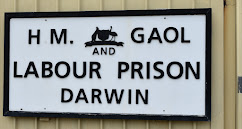The Captain is calling, " All on board, Stop smiling prisoner 321, this is not a fun ride, get to work."
The captain is assisting the passengers on board the Cat "O" nine tails, this is the boat that takes you out to the Island of Saint Helena. Originally a Leper colony and used for Quarantine, then changed to a prison for men only when Boggo Road Prison became over crowded. Peel Island became the place for Lepers. The last leper left Peel Island in 1982 and was transferred to Princess Alexandra Hospital.
 |
Prisoner 78 and 321 in front
|
 |
| Jetty and Guards swimming enclosure |
Prisoners were only allowed 1 visitor every 8 weeks for a time period of 20 minutes. Back in those days there was no motors on the boats to get out to the Island fast, so it was a long trip for a visit. A guard was present at all times. The visiting room, if you could call it that, had the visitors on one side and the prisoners on the other so that they could not touch or pass secret messages. The guard would walk between them at all times during the visit. There was no such thing as a free ride out to visit their family member either.
 |
The cell behind the Bakery
|
Cell Block B held 12 prisoners per cell. Their soft bed was a hammock, two high above each other with a bucket for the toilet and no privacy. The walls were all stone and in winter not very warm. Prisoners did all the work there, from baking, farming, harvesting, butcher, boot maker, blacksmithing, carpentry, and clothing. The items that were made on the Island were not just made for those living on the Island they were for the mainland too. When the wardens wife held a garden party on the island, one prisoner would be made to ride a bicycle behind the shed that would make the water flow in the fountains around the gardens.
When the prisoners arrived on the Island their pack consisted of a tin cup, plate, knife, fork, spoon and a comb. Which seems funny as the prisoners where shaved every couple of weeks. After 3 months if the prisoners where behaved they would earn luxuries like tea, sugar, soap and tobacco. These they could trade with other prisoners if they wanted something else. Bathing was done in the ocean in all weather conditions.
Meals consisted of the same dietary foods.
- 🍴Hominy - which was made from dried corn/maize kernels.
- 🍵Mutton/vegetables soup
- 🍲Mutton/ vegetable stew
The Bakers had a private cell behind the ovens, which was really nice in winter, but in summer the heat would be so unbearable the prisoners would ask to be chained up outside to sleep. Bakers were kept there so that they did not have to wake a guard in the early mornings to begin their job.
The island was also a farm, growing cabbages and sweet potatoes, sugar cane, cattle and sheep. Now you can see why the diet of the prisoners was not very varied in different types of foods. Later it became a cattle farm and dairy. Now it is a National Park and Queensland's first historical site in 1980.
There is the remains of a Lime kiln which would burn shells, coal and coral. The prisoners would have to keep the kiln burning constantly, this was hot work and if it came in contact with their skin would burn them. There are some olive trees growing on the Island and at the1889 Paris Expo the oil from these olives was voted best in the world.
 |
| Prisoner burial ground. |
The Island at any time would be home to 50 guards and their families, 350 prisoners. Three months to Seven years was considered short term. Seven years to life - Long Term. When a prisoner passed away on the Island they would be buried with a cross on top and given a number, their name was not put on the cross. Prisoners were asked to whip each other. Prisoners could be given time off their sentence if they whipped another prisoner. They were not allowed to be gentle, it had to be hard and forceful.
 |
| Whipping another prisoner. |
The tour includes lunch, which is at the top of the Island. Drinks such as alcohol and soft drinks, you are asked to pre order on the way out to the Island as it has to be carried to the top. After lunch the Captain and 2 prisoners give examples of the whipping that happened and ask some of the children in the tour to take part, which is really good and makes it interesting for those involved.
 |
| Lunch is served |
This tour is very interesting and one which these two green frogs would recommend that you take. The three main men that do the role play are very good and show how they dressed in those days. The visual plays were good, and you can see how they were treated in those days. It was a hard life and nothing like today. The prisoners were not just there to live, they were expected to work and work hard.
 |
| The wardens Office. |
 |
| The Children's Cemetery |
The Island is only accessible by boat tour. The walk around the Island is approximately 3klm on grass, there is a courtesy bus for those who find the walk too much in some places. It is not wheelchair friendly, though we would recommend that you call the company and ask before making a booking.
🐸 What other mysteries and facts can you "escape" with from one of Queensland's most Notorious Prisons?











Comments
Post a Comment